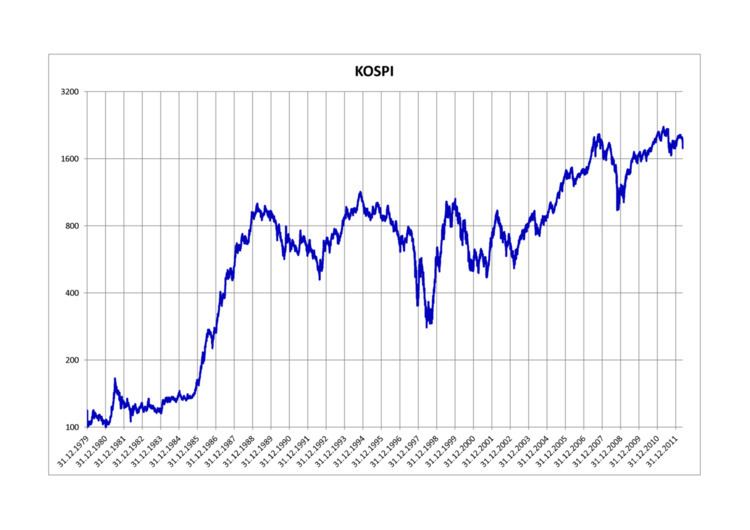Hangul 코스피지수 Revised Romanization Koseupi jisu | Hanja 코스피指數 McCune–Reischauer K'osŭp'i chisu | |
 | ||
The Korea Composite Stock Price Index or KOSPI (코스피지수) is the index of all common stocks traded on the Stock Market Division—previously, Korea Stock Exchange—of the Korea Exchange. It is the representative stock market index of South Korea, like the Dow Jones Industrial Average or S&P 500 in the United States.
Contents
- History
- Components
- Other indices
- KOSPI 200
- KRX 100
- KRX derivatives products
- Investment procedures for foreigners
- References
KOSPI was introduced in 1983 with the base value of 100 as of January 4, 1980. It is calculated based on market capitalization. As of 2007, KOSPI's daily volume is hundreds of millions of shares or (trillions of won).
History
KOSPI (한국종합주가지수 Hanguk jonghap juga jisu) was introduced in 1983, replacing Dow-style KCSPI (Korea Composite Stock Price Index).
For years, KOSPI moved below 1,000, peaking above 1,000 in April 1989, November 1994, and January 2000.
On June 17, 1998, KOSPI recorded its largest one-day percentage gain of 8.50% (23.81 points), recovering from the bottom of the Asian financial crisis.
On September 12, 2001, KOSPI had its largest one-day percentage drop of 12.02% (64.97 points) just after 9/11.
On February 28, 2005, KOSPI closed at 1,011.36, plunging to 902.88 in April. However, unlike previous bull traps, it kept moving upward, breaking the long-standing 1,000-point resistance level.
In November 2005, the index's Korean name was officially changed to Koseupi jisu (코스피지수).
On July 24, 2007, KOSPI broke 2,000 level for the first time. On July 25 it closed at 2,004.22.
On August 20, 2007, the index recovered 93.20 (5.69%), its largest one-day point gain, after the U.S. Federal Reserve lowered the discount rate. On October 16, 2008, the index dropped 126.50 (9.44%), after the Dow Jones Industrial Average dropped 7.87%.
Components
As of March 2015, KOSPI has over 760 components. Top 10 stocks by market capitalization are:
Other indices
KOSPI 200
The KOSPI 200 index consists of 200 big companies of the Stock Market Division. The base value of 100 was set on January 3, 1990. It has over 70% market value of the KOSPI, and so moves along with the KOSPI index. KOSPI 200 is important because it is listed on futures and option markets and is one of the most actively traded indices in the world. The KOSPI is calculated as current market capitalization (at the time of comparison) divided by base market capitalization (as of January 4, 1980).
That is: Current index = Current total market cap of constituents × 100 / Base Market Capitalization
Its all-time low is 31.96, reached on June 16, 1998, during the financial crisis. It closed above 200 for the first time on April 24, 2007.
KRX 100
KRX 100 is the index of 100 companies listed on Korea Exchange, including KOSDAQ's big companies. It's meant to replace KOSPI 200 as the key futures index, but has not been very successful to date.
KRX derivatives products
Investment procedures for foreigners
To trade futures and options contracts listed on KRX, a foreign investor may designate custodian banks as standing proxies (through custodian bank agreements and standing proxy agreements to facilitate trading).
A custodian bank as a standing proxy opens accounts at foreign exchange banks and futures companies, deposits, and withdrawals investors' money and monitors investors' properties for them. A foreign investor should designate foreign exchange banks through a foreign currency exchange agreement to execute his foreign exchange transactions and transfers. Most foreign exchange banks also do custodian bank and standing proxy operations. A foreign investor should designate securities and futures companies to trade futures and options traded on KRX.
